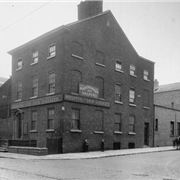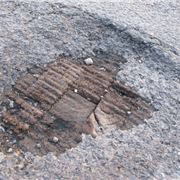Wooden setts and a hole in the road? Is this interesting at all?
True, it is a hole in the road. But it’s also a window.
It’s a boarded up window into the archaeology of paving.
Stop it. You’re going too far now.
Seriously I love these little glimpses back through the years, especially when they are suddenly and accidentally revealed as these have been. These babies get me thinking about how cities morph and change. I find it calming.
Since you’re so sett in your ways - ho,ho- let’s go back a bit. Where are we talking about and when were the setts laid?
The setts are on Byrom Street just where it meets Artillery Street and just up from the junction with Quay Street. They’re at least a hundred years old.
But why are they wooden?
For quietness, for a bit of shush. Wooden setts were used because iron horseshoes rattling over stone setts pulling carts with wheels also wrapped in iron makes a din. The more carts you have, the more din you have. Iron and stone don’t get on too well either, they scream and squeal like high pitched vuvuzelas when they come into contact. Iron and wood don’t mind each other. Wooden setts thus dampened the sound of the horses, carriages and carts.
But everywhere else you see stone setts
You do, because in the end they are more hard-wearing and less trouble as you don’t have to replace them so much. But in this place from the first half of the nineteenth century there was a hospital. The wooden setts were to ensure a bit of peace and quiet for the patients. They would often be used under bridges to dampen the echoes too. Or outside libraries.
So which hospital was here?
It was the delightful sounding Manchester and Salford Hospital for Skin Diseases which grew out of the Manchester and Salford Institution for the Treatment of Skin which was founded in 1835. Originally it was housed in the old Georgian town house as seen on the picture below.
 This is the original hospital. Looks a bit small
This is the original hospital. Looks a bit small
It was. In 1905 Percy Worthington’s designs for a massive rebuild in big bold Baroque were carried out at a cost of £34,043. This was handsome structure, elaborate, packing a punch but proportionate to the street it sat upon. The double towered and domed service entrance on Byrom Street was superbly handled giving a drama to function. Percy Worthington, by the way, was the son of Thomas Worthington, the prolific Manchester architect, who brought us the Albert Memorial in Albert Square and lots of other buildings.
Where’s the hospital gone now?
It was demolished, and the dreary corner office in the picture below was inserted into the space. There was a plan at one point for the Skin Hospital to be converted into apartments. It made me smile. Given that the title of the hospital was carved in stone above the main door I imagined the developer theming the conversion to skin complaints. I had visions of occupants answering the entrance buzzer with, “Yes, come up, I’m in Psoriasis, its right above Eczema.”
A bit flakey those jokes. Anything else?
Yep. There were loads of hospitals round here. A hundred yards behind the Opera House, which lies over the road here, there was the Hospital for Consumption and Diseases of the Throat. It seems that when you went to hospital in the olden days people immediately knew what you were in for – more or less. St Mary’s Hospital, for mums-to-be, was on Quay Street between 1855-1903 as well. There were so many hospitals because they were set up by specific charities for specific complaints. It wouldn’t be until the NHS after WWII that all hospital functions began to be gathered on singles sites. Let’s talk snacks for a minute.
Go on then
One story relating to the Skin Hospital comes from the days when there was a working class community round here. Patients would lower containers down on string from the windows to kids. The containers would contain coins and a note. The kids would then go and buy sweets and grub that the doctors weren’t allowing the patient to eat, and pocket a bit of change themselves. The kids would tease each other about catching diseases. Can we finish with the wooden setts again.
Be my guest
The wood of these soon-to-disappear artefacts is probably very well travelled. It’s probably tropical hardwood - very tough and hardworking timber better suited for paving, and more easily sourced than anything available from Europe at the time. In otherwords on Byrom Street you can look at a rainforest.
 The Skin Hospital in 1975 complete with Bay City Roller clad fan
The Skin Hospital in 1975 complete with Bay City Roller clad fan
You can follow Jonathan Schofield on Twitter here @JonathSchofield or connect via Google+












